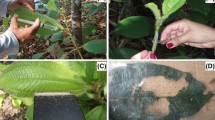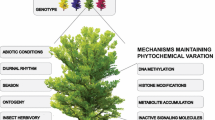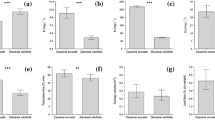Abstract
Plant strategies against herbivores are classically divided into chemical, physical, biotic defences. However, little is known about the relative importance of each type of plant defence, especially in the same species. Using the myrmecophyte Triplaris americana (both with and without ants), and the congeneric non-myrmecophyte T. gardneriana, we tested whether ant defence is more effective than other defences of naturally ant-free myrmecophytes and the non-myrmecophyte congeneric species, all spatially co-occurring. In addition, we investigated how plant traits vary among plant groups, and how these traits modulate herbivory. We sampled data on leaf area loss and plant traits from these tree groups in the Brazilian Pantanal floodplain, and found that herbivory is sixfold lower in plants with ants than in ant-free plants, supporting a major role of biotic defences against herbivory. Whereas ant-free plants had more physical defences (sclerophylly and trichomes), they had little effect on herbivory—only sclerophylly modulated herbivory, but with opposite effects depending on ants’ presence and species identity. Despite little variation in the chemicals among plant groups, tannin concentrations and δ13C signatures negatively affected herbivory in T. americana plants with ants and in T. gardneriana, respectively. We showed that ant defence in myrmecophytic systems is the most effective against herbivory, as the studied plants could not fully compensate the lack of this biotic defence. We highlight the importance of positive insect-plant interactions in limiting herbivory, and therefore potentially plant fitness.



Similar content being viewed by others
References
Agrawal AA (2007) Macroevolution of plant defense strategies. Trends Ecol Evol 22:103–109. https://doi.org/10.1016/j.tree.2006.10.012
Agrawal AA (2011) Current trends in the evolutionary ecology of plant defence. Funct Ecol 25:420–432. https://doi.org/10.1111/j.1365-2435.2010.01796.x
Agrawal AA, Weber MG (2015) On the study of plant defence and herbivory using comparative approaches: how important are secondary plant compounds. Ecol Lett 18:985–991. https://doi.org/10.1111/ele.12482
Agrawal AA, del Alba LE, Lopez-Goldar X et al (2022) Functional evidence supports adaptive plant chemical defense along a geographical cline. Proc Natl Acad Sci U S A 119:1–8. https://doi.org/10.1073/pnas.2205073119
Alho CJR, Lacher TE Jr, Gonçalves HC (1988) Environmental Degradation Pantanal Ecosystem. Bioscience 38:164–171
Barrie A, Prosser SJ (1996) Automated analysis of light–element stable isotopes by isotope ratio mass spectrometry. In: Boutton TW, Yamsahi S (eds) Mass spectrometry of soils. Marcel Dekker, New York, pp 1–46
Beattie A (1989) Myrmecotrophy: plants fed by ants. Trends Ecol Evol 4:172–176
Berenbaum MR, Zanger AR (2008) Facing the future of plant-insect interaction research: Le retour à la “raison d’être.” Plant Physiol 146:804–811. https://doi.org/10.1104/pp.107.113472
Braga L, Diniz IR (2015) The abundance of specialist and generalist lepidopteran larvae on a single host plant species: does spatial scale matter? Florida Entomologist 98:954–961. https://doi.org/10.1653/024.098.0323
Brandbyge J (1986) A revision of the genus Triplaris (Polygonaceae). Nord J Bot 6:545–570. https://doi.org/10.1111/j.1756-1051.1986.tb00454.x
Brandbyge J (1990) Woody Polygonaceae from Brazil: new species and a new interpretation. Nord J Bot 10:155–160. https://doi.org/10.1111/j.1756-1051.1990.tb01763.x
Cárdenas RE, Valencia R, Kraft NJB et al (2014) Plant traits predict inter- and intraspecific variation in susceptibility to herbivory in a hyperdiverse Neotropical rain forest tree community. J Ecol 102:939–952. https://doi.org/10.1111/1365-2745.12255
Carmona D, Lajeunesse MJ, Johnson MTJ (2011) Plant traits that predict resistance to herbivores. Funct Ecol 25:358–367. https://doi.org/10.1111/j.1365-2435.2010.01794.x
Coley PD (1983) Herbivory and defensive characteristics of tree species in a lowland tropical forest. Ecol Monogr 53:209–234
Coley PD, Barone JA (1996) Herbivory and plant defenses in tropical forests. Annu Rev Ecol Syst 27:305–335. https://doi.org/10.1146/annurev.ecolsys.27.1.305
Dejean A, Petitclerc F, Compin A et al (2017) Hollow internodes permit a neotropical understory plant to shelter multiple mutualistic ant species, obtaining protection and nutrient provisioning (myrmecotrophy). Am Nat 190:E124–E131
Dejean A, Orivel J, Rossi V et al (2013) Predation success by a plant-ant indirectly favours the growth and fitness of its host myrmecophyte. PLoS One 8(3):e59405. https://doi.org/10.1371/journal.pone.0059405
Del Val E, Dirzo R (2003) Does ontogeny cause changes in the defensive strategies of the myrmecophyte Cecropia peltata? Plant Ecol 169:35–41. https://doi.org/10.1023/A:1026227811685
Dethier VG (1941) Chemical factors determining the choice of food plants by Papilio larvae Author. Am Nat 75:61–73
Diniz IR, Morais HC, Botelho AMF et al (1999) Lepidopteran caterpillar fauna on lactiferous host plants in the central Brazilian cerrado. Rev Bras Biol 59:627–635. https://doi.org/10.1590/S0034-71081999000400012
Dyer LA, Dodson CD, Beihoffer J, Letourneau DK (2001) Trade-offs in antiherbivore defenses in Piper cenocladum: ant mutualists versus plant secondary metabolites. J Chem Ecol 27:581–592
Eck G, Fiala B, Linsenmair KE et al (2001) Trade-off between chemical and biotic antiherbivore defense in the south east Asian plant genus Macaranga. J Chem Ecol 27:1979–1996
Gomes IJMT, Solar R, Blüthgen N et al (2021) Multiple effects of mutualistic ants improve the performance of a Neotropical ant-plant: a long-term study with the Cecropia-Azteca system. Basic Appl Ecol. https://doi.org/10.1016/j.baae.2021.09.004
González-Teuber M, Heil M (2009) The role of extrafloral nectar amino acids for the preferences of facultative and obligate ant mutualists. J Chem Ecol 35:459–468. https://doi.org/10.1007/s10886-009-9618-4
Hagerman A (2002) Tannin Chemistry Handbook. Miami University Oxford, Ohio, USA
Hawkes CV, Sullivan JJ (2001) The impact of herbivory on plants in different resource conditions: a meta-analysis. Ecology 82:2045. https://doi.org/10.2307/2680068
Heil M, McKey D (2003) Protective ant-plant interactions as model systems in ecological and evolutionary research. Annu Rev Ecol Evol Syst 34:425–453. https://doi.org/10.1146/132410
Heil M, Delsinne T, Hilpert A et al (2002) Reduced chemical defence in ant-plants? A critical re-evaluation of a widely accepted hypothesis. Oikos 99:457–468. https://doi.org/10.1034/j.1600-0706.2002.11954.x
Janzen DH (1966) Coevolution of Mutualism between ants and acacias in Central America. Evol 20:249–275. https://doi.org/10.2307/2406628
Junk WJ, Silva CJ, Cunha CN, Wantzen KM (eds) (2011) The Pantanal: ecology, biodiversity and sustainable management of a large neotropical seasonal wetland. Pensoft Pub, Moscow
Kause A, Ossipov V, Haukioja E et al (1999) Multiplicity of biochemical factors determining quality of growing birch leaves. Oecologia 120:102–112
Kudo G (2003) Variations in leaf traits and susceptibility to insect herbivory within a Salix miyabeana population under field conditions. Plant Ecol 169:61–69. https://doi.org/10.1023/A:1026209017627
Kudo G (1996) Herbivory pattern and induced responses to simulated herbivory in Quercus mongolica var. grosseserrata. Ecol Res 11:283–289
Kurokawa H, Nakashizuka T (2008) Leaf Herbivory and decomposability in a Malaysian tropical rain forest. Ecology 89:2645–2656. https://doi.org/10.1890/07-1352.1
Latteman TA, Mead JE, Duvall MA et al (2014) Differences in anti-herbivore defenses in non-myrmecophyte and myrmecophyte Cecropia trees. Biotropica 46:652–656. https://doi.org/10.1111/btp.12163
Leroy C, Séjalon-Delmas N, Jauneau A et al (2011) Trophic mediation by a fungus in an ant-plant mutualism. J Ecol 99:583–590. https://doi.org/10.1111/j.1365-2745.2010.01763.x
Marquis RJ, Moura RF (2021) Escape as a mechanism of plant resistance against herbivores. Plant-Animal Interactions. Springer International Publishing, Cham, pp 39–57
Marting PR, Wcislo WT, Pratt SC (2017) Colony personality and plant health in the Azteca-Cecropia mutualism. Behav Ecol 00:1–8. https://doi.org/10.1093/beheco/arx165
Massad TJ (2013) Ontogenetic differences of herbivory on woody and herbaceous plants: a meta-analysis demonstrating unique effects of herbivory on the young and the old, the slow and the fast. Oecologia 172:1–10. https://doi.org/10.1007/s00442-012-2470-1
Massad TJ, Fincher RM, Smilanich AM, Dyer L (2011) A quantitative evaluation of major plant defense hypotheses, nature versus nurture, and chemistry versus ants. Arthropod Plant Interact 5:125–139. https://doi.org/10.1007/s11829-011-9121-z
Mattson WJ (1980) Herbivory in relation to plant nitrogen content. Annu Rev Ecol Syst 11:119–161. https://doi.org/10.1146/annurev.es.11.110180.001003
Mayer VE, Frederickson ME, Mckey D, Blatrix R (2014) Current issues in the evolutionary ecology of ant-plant symbioses. New Phytol 202:749–764. https://doi.org/10.1111/nph.12690
Mithöfer A, Boland W (2012) Plant defense against herbivores: chemical aspects. Annu Rev Plant Biol 63:431–450. https://doi.org/10.1146/annurev-arplant-042110-103854
Ohata M, Furumoto A, Ohsaki N (2010) Local adaptations of larvae of the butterfly Pieris napi to physical and physiological traits of two Arabis plants (Cruciferae). Ecol Res 25:33–39. https://doi.org/10.1007/s11284-009-0625-2
Oliveira PS, Oliveira-Filho AT, Cintra R (1987) Ant foraging on ant-inhabited Triplaris (Polygonaceae) in western Brazil : a field experiment using live termite-baits. J Trop Ecol 3:193–200
Penatti NC, de Almeida TIR, Ferreira LG et al (2015) Satellite-based hydrological dynamics of the world’s largest continuous wetland. Remote Sens Environ 170:1–13. https://doi.org/10.1016/J.RSE.2015.08.031
Pringle EG, Dirzo R, Gordon DM (2011) Indirect benefits of coccoids symbiotic tree for an ant-defended myrmecophytic. Ecology 92:37–46
Ramawat KG, Goyal S (2020) Co-evolution of secondary metabolites during biological competition for survival and advantage: an overview. In: Mérillon J-M, Ramawat KG (eds) Co-Evolution of Secondary Metabolites. Springer International Publishing, Cham, pp 3–17
Rasband WS (2006) ImageJ, U.S. National Institutes of Health, Bethesda, Maryland, USA, https://imagej.nih.gov/ij/.
R-Core-Team (2022) R: a landuage and environment for Statistical Computing. http://www.r-project.org/
Rehr SS, Feeny PP, Janzen DH (1973) Chemical defence in Central American non-ant-acacias. J Anim Ecol 42:405. https://doi.org/10.2307/3294
Roglin A, Sousa NJ, de Souza MD et al (2013) Avaliação dos danos causados por formigas cortadeiras em espécies nativas do cerrado de áreas degradadas em processo de recuperação. Enciclopédia Biosfera 9:434–442
Rosumek FB, Silveira FAO, Neves DS, F, et al (2009) Ants on plants: a meta-analysis of the role of ants as plant biotic defenses. Oecologia 160:537–549. https://doi.org/10.1007/s00442-009-1309-x
Sagers CL, Ginger SM, Evans RD (2000) Carbon and nitrogen isotopes trace nutrient exchange in an ant-plant mutualism. Oecologia 123:582–586. https://doi.org/10.1007/PL00008863
Sanchez A (2016) Establishing an ant-plant mutualism: foundress queen mortality and acquiring the third partner. Insectes Soc 63:155–162. https://doi.org/10.1007/s00040-015-0450-2
Sanchez A, Bellota E (2015) Protection against herbivory in the mutualism between Pseudomyrmex dendroicus (Formicidae) and Triplaris americana (Polygonaceae). J Hymenopt Res 46:71–83. https://doi.org/10.3897/JHR.46.5518
Schmitz OJ (2008) Herbivory from individuals to ecosystems. Annu Rev Ecol Evol Syst 39:133–152. https://doi.org/10.1146/annurev.ecolsys.39.110707.173418
Schuldt A, Bruelheide H, Durka W et al (2012) Plant traits affecting herbivory on tree recruits in highly diverse subtropical forests. Ecol Lett 15:732–739. https://doi.org/10.1111/j.1461-0248.2012.01792.x
Seigler DS, Ebinger JE (1987) Cyanogenic glycosides in ant-acacias of Mexico and Central America. Southwest Nat 32:499–503. https://doi.org/10.2307/3671484
Swain T, Hillis WE (1959) The phenolic constituents of Prunus domestica. I.—the quantitative analysis of phenolic constituents. J Sci Food Agric 10:63–68. https://doi.org/10.1002/jsfa.2740100110
Trager MD, Bhotika S, Hostetler JA et al (2010) Benefits for plants in ant-plant protective mutualisms: a meta-analysis. PLoS One 5(12):e1430. https://doi.org/10.1371/journal.pone.0014308
Turley NE, Godfrey RM, Johnson MTJ (2013) Evolution of mixed strategies of plant defense against herbivores. New Phytol 197:359–361. https://doi.org/10.1111/nph.12103
Ward PS (1999) Systematics, biogeography and host plant associations of the Pseudomyrmex viduus group (Hymenoptera: Formicidae), Triplaris- and Tachigali-inhabiting ants. Zool J Linn Soc 126:451–540. https://doi.org/10.1111/j.1096-3642.1999.tb00157.x
Ward PS (1991) Phylogenetic analysis of Pseudomyrmecine ants associated with domatia-bearing plants. In: Huxley CR, Cutler DF (eds) Ant-plant interactions. Oxford University Press, pp 335–352
Weddell HA (1850) Additions à la flore de l'Amérique du Sud (Suite). [part]. Ann Sci Nat Bot 13(3):257–268
Wink M (1988) Plant breeding: importance of plant secondary metabolites for protection against pathogens and herbivores. Theor Appl Genet 75:225–233. https://doi.org/10.1007/BF00303957
Xiang H, Chen J (2004) Interspecific variation of plant traits associated with resistance to herbivory among four species of Ficus (Moraceae). Ann Bot 94:377–384. https://doi.org/10.1093/aob/mch153
Zhang S, Zhang Y, Ma K (2015) The equal effectiveness of different defensive strategies. Sci Rep 5:1–9. https://doi.org/10.1038/srep13049
Acknowledgements
We thank our colleagues, professors and staff from the Pantanal Ecology Field Course (Ecopan 2016), who provided insights and conditions that greatly assisted this research. All parts of this work comply with the current research laws of Brazil. Finally, we thank three anonymous referees for their comments in previous versions of this manuscript.
Funding
Financial support was provided by Coordenação de Aperfeiçoamento de Pessoal de Nível Superior and Fundação de Amparo à Pesquisa do Estado de Minas Gerais (fellowship to IJMTG).
Author information
Authors and Affiliations
Corresponding author
Ethics declarations
Conflict of interest
The authors declare no competing interests.
Disclaimer
The corresponding author confirms on behalf of all authors that there have been no involvements that might raise the question of bias in the work reported or in the conclusions, implications, or opinions stated.
Additional information
Communicated by: Tatiana Cornelissen
Publisher's note
Springer Nature remains neutral with regard to jurisdictional claims in published maps and institutional affiliations.
Supplementary Information
Below is the link to the electronic supplementary material.
Rights and permissions
Springer Nature or its licensor (e.g. a society or other partner) holds exclusive rights to this article under a publishing agreement with the author(s) or other rightsholder(s); author self-archiving of the accepted manuscript version of this article is solely governed by the terms of such publishing agreement and applicable law.
About this article
Cite this article
de Melo Teles e Gomes, I.J., Neves, M.O. & Paolucci, L.N. Trees harbouring ants are better defended than con-generic and sympatric ant-free trees. Sci Nat 110, 31 (2023). https://doi.org/10.1007/s00114-023-01858-5
Received:
Revised:
Accepted:
Published:
DOI: https://doi.org/10.1007/s00114-023-01858-5




